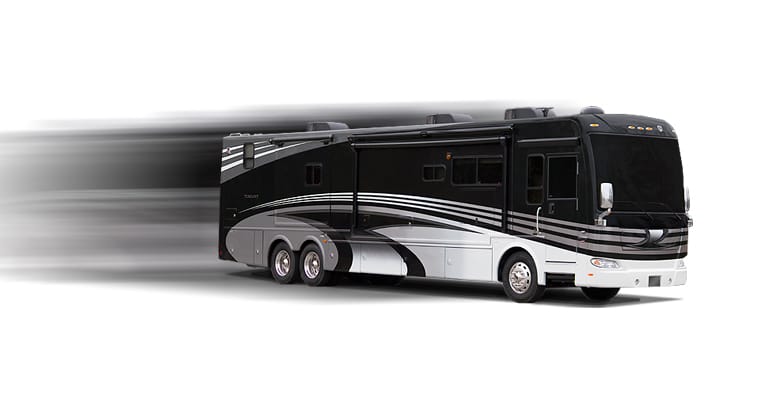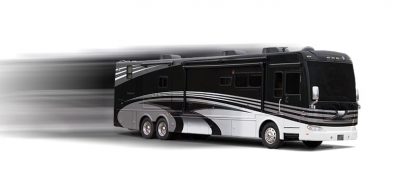RV auxiliary braking helps with smooth slowing of your recreational vehicle.

Auxiliary Braking
Auxiliary braking is a term often associated with diesel-powered recreational vehicles and RV tow units. It basically refers to a braking system that uses engine and transmission drag to slow, or check, the speed of the vehicle. There are three main principle types as listed below.
Exhaust Brakes (Pacbrake): This consists of a butterfly-like valve located at the exhaust manifold that can be closed to restrict the output of the hot gases. This restriction causes a heavy drag on the driveline as the engine’s rotation resistance load increases. A relief-type valve controls the maximum pressure to safeguard the engine. In most cases, the electronic operation of these also engage the seeking of a lower gear to further add to the braking power.
Jake, or Engine Compression Brake: These auxiliary brake types are the design employed on commercial semi trucks. The Jake design, using a mechanical configuration combined with electronic solenoids, turns the engine into a compressor. The generating of the resulting pressure supplies a great deal of controlled vehicle drag. There can be three degrees of resistance on a six-cylinder diesel: low, using only two cylinders; medium, employing four; or high, using all six cylinders. These also are coordinated with an auto-shift transmission gear selection to increase the effect. The Jake Brake can produce a tremendous amount of slowing power. For example, a Cummins ISX 15 liter engine with an Allison 4000 series transmission can deliver over 600 horsepower of braking force.
Transmission Grade Retarder: These can have multi-levels of resistance control and use internal transmission torque converter friction drag. They are capable of very powerful resistances. This process produces excess heat to absorb the energy. The additional heat is passed on to the engine cooling system.
Auxiliary Braking Insights
So, why are these braking systems found primarily on diesel powered units? Well, unlike the gasoline replicating engine, diesels do not have air intake valves that offer air flow resistance when in the closed position. Instead, diesel motors are wide open, relying on fuel delivery only. In other words, gas engines offer a reasonable drag resistance when in the throttle closed position. That is not to say that the addition of an auxiliary brake on a gas unit is never done, as it certainly is. It is just not required at the same level due to its natural ability to decelerate when at idle state.
Best Braking
So, what is the best auxiliary brake out there? Well, it is probably the one your rig came equipped with. The type, model and number of speed selections are generally chosen specifically for the weight and design of the unit. The exhaust brake is normally found on the lower weight vehicles with both the Jake and the less popular transmission retarder reserved for the heavyweights. Regardless of the type, most motor homes are configured to illuminate the brake lights whenever the auxiliary braking is engaged to warn traffic behind of the deceleration.
Always make sure to regularly service your vehicle.
Note: All auxiliary brakes only apply at the drive axle(s). Therefore use on wet or slippery surfaces should be avoided.
Peter Mercer – With a Slowing Thought






